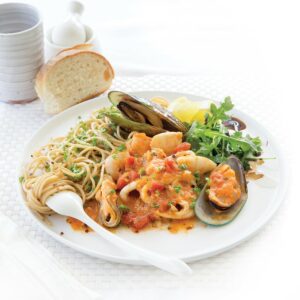
To be quite honest, planning is a really, really important tool if you are wanting to eat well.
Whenever I say the words ‘meal planning’ I can just hear the sighs, oh nos and… do we really have to? Honestly though, it sounds worse than it is and boy, the investment of 5-10 minutes of your time each week can save you from wandering aimlessly (and hungrily) around the supermarket trying to work out what to eat (yes, I have seen you – it’s painful to watch, I don’t know how people do it!). It can also save you money and mean that you eat better after all – and all this from an A4 piece of paper and a pen!!!! SO… to make it more appealing, let’s rename this process; I’d like to suggest we call it POWER planning. 🙂
Your POWER plan doesn’t need to be fancy! So long as it works for you. Here is what mine looks like:

This is my step-by-step guide to POWER planning
Step 1 – Get an A4 piece of paper, fold it in half.
Step 2 – On one side of the paper, scribble a quick table (see my picture – this is an example I started, not complete though – or I’d be starving!) with the days of the week you are shopping for and lunch and dinner columns.
Step 3 – On the other side, put the name of your supermarket and then butcher/fruit and veg if you buy those things separately.
Step 4 – Start with dinners and decide what you would like for the week. Think NOW about when you are going out, what you have got on etc. I would be looking to be having red meat x 1-2, chicken x 1-2, fish x 1-2 and some kind of vegetarian or egg-based meal about once a week (I always have omelette on our busiest night).
Step 5 – Work out what things you can use from dinner the night before for a lunch the next day (see my arrows!). For example: when I make an omelette, as I am on ‘egg mode’ I will boil eggs for our lunches the next day; if we have chilli, then it’s mince on toast; after a roast dinner, a roast vege salad.
Step 6 – On the day when leftovers won’t make anything for lunch, what else can you have? Soup? Sandwiches? Wraps? Salad? Jot it down so you know what you are having.
Step 7 – Write your shopping list on the other side of the page. Start with what you need for dinners, then lunches, and then think about the basics you need – cereal, milk, yoghurt, snacks etc.
Step 8 – Now add the extras you may need (Janola, paper towels etc).
Step 9 – Shopping time.
Step 10 – Pop the plan on the fridge so everyone knows what you are having! You may end up with two or three things in each box if you are catering for a few different lunches.
This has saved me SO much money and encourages me to try new things! Every week, I will try to make one new recipe to keep things interesting!
So, will you embrace meal planning? Share your ideas and comments below. Plus, make sure you share this blog with your friends and family!
Until next time… happy healthier living.
www.healthyfood.com










